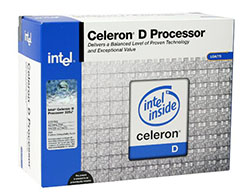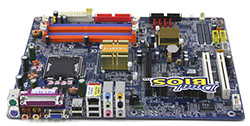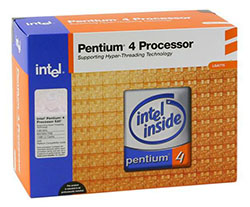Buyer's Guide - Entry Level to Mid-Range, March 2005
by Jarred Walton on March 15, 2005 1:30 PM EST- Posted in
- Guides
CPU and Motherboard: Intel
Unlike the AMD picture, where we have some real changes from our last Budget Guide, the Intel budget offerings are pretty much the same as last time. Considering the increased performance, lower power/heat requirements, and potential for 64-bit support that AMD offers, Intel doesn't really look that good. EM64T is only available starting at the $200+ processors, although we should start seeing some new Celeron D parts in Q2 that include EM64T. However, since we've switched from socket A in AMD-land, we'll ditch socket 478 in Intel-land as well. They're both being phased out rapidly these days, so we can't see advocating a purchase of a new system using a dying platform anymore.For a budget system, we're still looking primarily at Celeron D processors, as even the cheapest Pentium 4 chips will cost $150. (Certain socket 478 Pentium 4 chips are slightly cheaper, but again, we can't see recommending the 478 platform.) The motherboard chipset is a little harder to decide on, as you have 865 and 915 offerings to sort through. 865G/PE will cost less typically and allow you to use an AGP card, while 915G/P support PCI Express graphics cards. If you want integrated graphics, we'd go with an 865G motherboard, as the 915G boards are all rather expensive for a budget system. 865PE with a cheap AGP card would cost as much as most 915G boards (and generally perform better as well)! We're going to avoid the IGP options on socket 775 for this reason and go with 915P.
 |
 |
| Click images to enlarge. | |
Socket 775/T Motherboard: EPoX EP-5EPAJ 915P
Price: $82 shipped
Socket 775/T CPU: Intel Celeron D 325J 2.53 GHz 256K L2 Cache
Price: $84 shipped (Retail)
Total: $166
The best that we could come up with for a reasonable 775 system again uses an EPoX motherboard. Features are similar to the 8KDA3J that we used for our AMD system, only with an Intel chipset instead of an NVIDIA chipset. The hardware firewall is no longer present, of course, but gigabit Ethernet remains. Firewire support and HD audio are also missing. Remember that the 915 chipset is a PCI Express solution, so you will need a newer graphics card in order to use this motherboard. 915G motherboards will remove this requirement, but we suggest that you stick with the more expensive 915G as opposed to the 915GV/GL chipsets. See our alternative choice below.
Our processor of choice happens to be the cheapest (and slowest) option available for socket 775. It's not necessarily bad, of course, and for most tasks, it will perform well enough. Gaming is not one of those tasks, however, so if that's what you're after, go back to the AMD recommendations, please.
 |
 |
| Click images to enlarge. | |
Socket 775/T Motherboard Alternative: Gigabyte GA-8I915G Pro i915G
Price: $99 shipped
Socket 775/T CPU Alternative: Intel Pentium 4 520 2.8 GHz 1024K L2 Cache
Price: $152 shipped (Retail)
Total: $251
Our alternative upgrades to the base socket 775 recommendation uses a Gigabyte motherboard for its improved features. Among the additions are Azalia HD audio support and firewire ports, and we even get the integrated GMA-900 graphics as a bonus. Truth be told, you could use this motherboard as the "budget" option and skip the requirement for an add-in graphics card. The 915G and 915P chipsets are otherwise identical, so having the VGA port doesn't hurt, even if you never use it. The one area where the Gigabyte board may fall a little short is in overclocking support. If that's a real concern, the Abit AG8 is probably the next step up, but prices increase rapidly.
Our upgraded processor choice for Intel is once again their cheapest offering for socket 775; only this time, we've eliminated the Celeron from contention. That leaves us with the Pentium 4 520J, and the price is unchanged from our last budget Guide. At 2.8 GHz, the Pentium 4 is typically slower than any of the Athlon 64 processors. Of course, Intel still does a little better in a few applications like video encoding, provided that they have proper optimizations for the architecture. This is the bare minimum Intel P4 system with PCI Express support, though, and most people will be satisfied with the performance.










59 Comments
View All Comments
JarredWalton - Tuesday, March 15, 2005 - link
17 - The older Maxtor are like the older WD: they use standard bearings and are prone to develop a whine (in my experience). If you can verify that the drive has fluid dynamic bearings, you could get Maxtor as well. I haven't had great experiences with the Maxtor drives, although I've heard the latest models are better.JarredWalton - Tuesday, March 15, 2005 - link
15 - Sorry, I meant "9550" but typed "5500". The article lists the correct card, though. :o Most of the FX cards aren't worth consideration.As for the 6200TC, there are actually 3 versions, all of which were tested in the AnandTech article. There is a 16MB 16-bit card (one RAM chip), a 32MB 32-bit card (two RAM chips), and a 64MB 64-bit card (four RAM chips). The 32MB cards are not a 64-bit interface as far as I am aware. Many companies are causing confusion on the TC cards as they'll count the PCIe connection as bandwidth in order to make the features look better. Even if the RAM were 700 MHz instead of 550 MHz, you're looking at 2800 MBps on-card bandwidth for the 32-bit version vs. 4400 MBps on the 64-bit version. In theory, the PCIe connection will add an additional 2000 MBps (roughly - 2000 up and 2000 down) , but some of the RAM bandwidth is going to the CPU.
16 - I'd take the guaranteed 6600 for $7 more over the 6200. The 6200 also lacks support for certain memory compression schemes as I understand it.
Klober - Tuesday, March 15, 2005 - link
I know this is a minor point, but I'm curious as to why Maxtor isn't mentioned in the price guide for hard drives. Is there something I don't know about them concerning speed, noise or reliability?filterxg - Tuesday, March 15, 2005 - link
To most people I'd continue to recommend a 6200 over a 6600 vanilla. Rivatuner unlocks the 4 pipelines (softmod), so it becomes an indentical card.Jep4444 - Tuesday, March 15, 2005 - link
"Oh, as far as the budget PCIe card recommendation going to the 64MB 6200TC, please read the benchmarks in our 6200TC article before saying that the 32MB/32-bit version is better (due to memory speeds)."you seem to be confusing cards, i'm talking about the 32MB/64bit part thats clocked at 700mhz(as opposed to 550mhz of the 64MB one)
you're thinking of the 16MB version thats 32bit
PS who said to use the 5500? he mentioned the 9550 which is faster than the 5500
JarredWalton - Tuesday, March 15, 2005 - link
13 - Regarding refurb, that's something for the individual to decide. Warranty and availability are limited, so we don't recommend them in Guides. I still don't know about the Chaintech, as I can't find concrete information on specs for the Ultra vs. standard. According to Chaintech, it's the standard nF4 vs. the Ultra, which means the only thing that gets lost is SATA-2 support and a few network "enhancements". They're the same chipset with different resistors cut.Fricardo - Tuesday, March 15, 2005 - link
Same as those above, I'd say go with a 6600 non-gt for the upgraded setup. If you're actually going to upgrade the vid-card -- indicating you care somewhat about gaming -- you might as well do it right and spend the extra $7.Is it worth the $10 savings to go from the Ultra mobo to the vanilla? I don't know but I've heard that chipset wasn't made to OC well. Seems like you'd get a bit more value and $99 is still a great price for a mobo. I'm just wondering.
Another possibility for reducing cost is refurbed parts. I've been looking through NewEgg's refurb video section lately and there's tons of great cards for cheap. PCI-Express too. It seems to me you can really raise value that way.
JarredWalton - Tuesday, March 15, 2005 - link
Oh, as far as the budget PCIe card recommendation going to the 64MB 6200TC, please read the benchmarks in our 6200TC article before saying that the 32MB/32-bit version is better (due to memory speeds). The bump from 32-bit to 64-bit more than makes up for the slower RAM (if it is indeed slower). The 64MB 6200TC also beats the X300 in *every* test, so there's no reason to go with the X300 card unless you insist on ATI.http://www.anandtech.com/video/showdoc.aspx?i=2300...
I'm actually not fully convinced the "TurboCache" architecture really works all that well. Looking at the various cards, the performance scales almost directly with local memory bandwidth. But that's a topic for another day.
JarredWalton - Tuesday, March 15, 2005 - link
Oops... some bad picks on the GPUs this time. I keep forgetting the 5500. I have updated the GPU page with new picks, and will shortly update the summaries. I guess after seeing 6600 AGP prices I forgot that the PCIe cards were substantially less. Sorry.I also corrected the VNF4 to omit the Ultra. I can't tell if the Ultra includes Firewire support or not. Newegg, at least, is using the same images for both models. I think that's what threw me off in the first place.
rivethead - Tuesday, March 15, 2005 - link
Sorry about my post #7. I just re-read it and I wasn't very clear.What I was trying to say is that I think you're wanting to recommend the Chaintech VNF4 mother board (currently $89 shipped from newegg). This board is different than the Chaintech VNF4/Ultra which is about $100 shipped. For the extra $11, you get a motherboard powered by the nvidia nForce 4 Ultra chip which includes onboard firewall, SATA2 support, and nvidia nTune performance software.
For me, I think the extra $11 is worth the features.
I beleive you'll need to either change the price or alter the narrative to be clearer on your board selection.
But if you really can find the Chaintech VNF4/Ultra for $89 please let me know where!